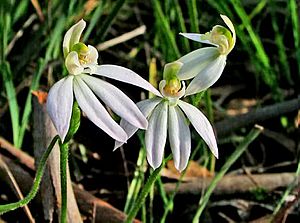Long-leaf fingers facts for kids
Quick facts for kids Long-leaf fingers |
|
|---|---|
 |
|
| Caladenia prolata growing near Beaufort | |
| Scientific classification | |
| Genus: |
Caladenia
|
| Species: |
prolata
|
| Synonyms | |
|
Petalochilus prolatus (D.L.Jones) D.L.Jones & M.A.Clem. |
|
Caladenia prolata, often called long-leaf fingers or white fingers, is a special type of orchid plant. It grows only in southern Australia. This ground orchid has a single leaf and usually one or two dull white flowers. The flowers are greenish with cool red stripes on their back.
Contents
What it Looks Like
Caladenia prolata is a plant that grows from an underground tuber. It's a perennial herb, meaning it lives for more than two years. It usually grows as single plants.
This orchid has one straight, hairy leaf. The leaf is about 120 to 200 mm (5-8 inches) long and 3 to 5 mm (0.1-0.2 inches) wide. Its base is often reddish or purplish.
One or two dull white flowers grow on a stem about 120 to 240 mm (5-9 inches) tall. The flowers are hairy and have green parts with red stripes on the back. Each flower is about 8 to 10 mm (0.3-0.4 inches) long and 12 to 15 mm (0.5-0.6 inches) wide.
The top part of the flower, called the dorsal sepal, curves forward. It forms a small hood over the column (the central part of the flower). This sepal is about 11 to 14 mm (0.4-0.6 inches) long. The side sepals are slightly curved and spread out.
The petals are about 10 to 13 mm (0.4-0.5 inches) long and spread widely. The labellum (the orchid's special lip petal) is dull pink. It has dark red stripes and a yellow tip. It's about 5 to 6 mm (0.2 inches) long. The sides of the labellum have small teeth near the tip. There are also two rows of white or yellow bumps, called calli, down the middle.
Flowering Time
These interesting orchids usually bloom in October and November.
Naming the Plant
How it Got its Name
The plant Caladenia prolata was first officially described in 1991. This was done by a botanist named David Jones. The description was published in a book called Australian Orchid Research.
The second part of its name, prolata, is a Latin word. It means "extended" or "elongated." This name was chosen because the plant's ovary (the part that holds the seeds) is longer than in similar orchid species. An example of a similar species is C.vulgaris.
Where it Lives
Habitat and Distribution
Caladenia prolata has been found in different places across southern Australia. You can find it in Victoria, south-eastern South Australia, and on Flinders Island and Deal Island in Tasmania.
This orchid likes to grow in coastal scrub areas. It also lives in heathy forests. Sometimes, you can even spot it growing on granite rocks.

